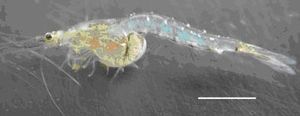Flame retardants organotin compounds and surfactants in opossum shrimps of the Scheldt estuary.
Context of the study
Flame retardants (like PBDEs) are used globally and are very persistent when they end up in the environment. Surfactants (like APE) have also been widely produced, and most of them end up in the aquatic environment. Together with organotin compounds (like TBT), they are often detected at high levels, in estuarine waters all around the world. All three groups might have long term effects on the endocrine system. It remains uncertain how these compounds transfer to hyperbenthic communities.[1]
Content of the study
In the Scheldt estuary (one of the most contaminated estuaries in Western Europe), organotin compounds, flame retardants and surfactants were measured in sediments and in opossum shrimp. It was also examined whether the estuarine water, and sediments, showed estrogenic properties (and thus, whether there are contaminants present which could act as estrogens).
Main results of the study
Concentrations of organotin compounds, APEs and PBDEs were high in opossum shrimp (1110 ng/g, 1119 ng/g and 2095 ng/g dry weight respectively) and lower in the sediments (219 ng/g, not detected and 272 ng/g dry weight respectively). This result indicates that the Scheldt estuary is highly contaminated for organotin compounds (mainly by TBT). This is due to shipping, since TBT is mostly used in antifouling paints. TBT seems to accumulate in opossum shrimp at a much higher rate than in other species (perhaps due to lower TBT degradation), leading to higher concentrations in opossum shrimp than in fish. The PBDE concentrations are among the highest in Western Europe, and the values in opossum shrimp are extremely high. This is due to the high concentrations of PBDEs in the estuary (caused by industry in Antwerp, Terneuzen and other cities) and the fact that opossum shrimp eat lots of suspended particulate matter. Since PBDEs are mostly adsorbed to these particles, the shrimp eat high amounts of PBDEs.The study also showed, that the estuarine water and sediments contains relative high concentrations of substances which act as estrogens. It is suspected that this is due to the 3 groups of contaminants which are discussed .
This study concluded that the concerns about the potential effects of endocrine disrupting compounds on invertebrates in the Scheldt estuary are justified. [1]
References
Please note that others may also have edited the contents of this article.
|
